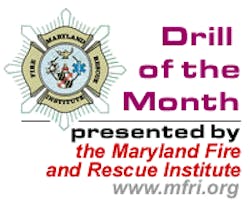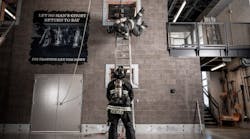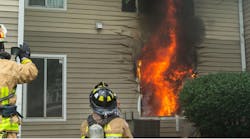COURSE: FIREFIGHTER PRE-BASIC
SESSION REFERENCE: 8
TOPIC: SEARCH AND RESCUE
TIME REQUIRED: THREE HOURS
MATERIALS: SELF CONTAINED BREATHING APPARATUS, PERSONAL PROTECTIVE CLOTHING, AREA TO CONDUCT SMALL AREA SEARCH
REFERENCES:
· ESSENTIALS OF FIRE FIGHTING, FOURTH EDITION, IFSTA, CHAPTER 7
· MINIMUM PRE-BASIC TRAINING PROGRAM FOR FIREFIGHTER TRAINEES IN
MARYLAND, MARYLAND FIRE-RESCUE EDUCATION AND TRAINING
COMMISSION
PREPARATION:
MOTIVATION:
OBJECTIVE (SPO): The student will demonstrate a basic understanding of search and rescue operations and consideration and search techniques and victim removal.
OVERVIEW:
Search and Rescue
* Introduction to Search and Rescue
* Rescue Considerations
* Rescue Techniques
SESSION 7 SEARCH AND RESCUE
SPO The student will demonstrate a basic understanding of search and rescue operations and consideration and search techniques and victim removal.
EO 8-1 Explain the principles involved in structure search and rescue.
EO 8-2 Explain the considerations related to conducting a search in various occupancies.
EO 7-3 Demonstrate the proper techniques for conducting a search of a small and large area and removal of victims by drags or carries.
This lesson should be delivered as a combination of demonstration and student practice with the minimum amount of time spent on lecture. This material is designed to give the student some basic information on structural search and rescue. It is not intended to replace a Firefighter I program nor make the individuals fully-functional firefighters. It includes some basic information that any new firefighter should know to assist in an exterior mode on the fireground. Instructor should have protective clothing, SCBA, search tools, rescue victims (dummies or other students), and props or a structure available for display, demonstration, and handling.
I. INTRODUCTION TO SEARCH AND RESCUE (8-1)
A. Timeliness of Searching
1. First consideration upon arrival at scene
2. Savings lives is the first objective of the fire service
3. May be initiated before hoselines are in place
B. Primary and Secondary Search
1. Primary is immediate, rapid, and systematic
2. Secondary is systematic, thorough, and performed by a different team
C. Search and Rescue Tools
1. Forcible entry tools (axe and pry bar)
2. Handlight
3. Rescue rope
4. Short piece of rope or webbing
5. Communications equipment
6. Marking devices
D. Search Procedures for Small and Large Areas
1. Mark entrance
2. Turn same direction at each turn
3. Maintain contact with wall
4. Search high and low as well as behind objects
5. Search closets and bathrooms
6. Use rope/webbing and tools to extend reach
7. Move furniture with caution to avoid injury to victims
E. Rescue Methods and Victim Removal
1. Move victim’s head first and in straight line to protect spine
2. Firefighters must work as a team
3. Use rope/webbing to form sling across chest and under arms
4. Sheets or other bedding, area rugs, and drapes can assist with victim removal
5. Reverse direction of movement
6. Drag victims rather than carry due to smoke
NOTE: Rescue of people in danger is the primary objective of a fire company
II. RESCUE CONSIDERATIONS (8-2)
A. Rescue - removing victims and potential victims from danger
1. Extent of rescue problem directly affected by
a. Number of people in fire building
b. Paths by which fire and smoke can reach them
c. Routes available to crews for reaching people and removing them from building
2. Factors depend on construction, size, and interior layout of building
3. Crew must be prepared for most complex structure
4. Rescue problem can tax capacity of first units - call for additional companies without delay
B. Residential Occupancies
1. Might require rescue operations at any time of day
2. Rescue situation more acute at night
a. Occupants asleep and off guard
b. More people in residence
3. Single family dwellings
a. Search area around fire on fire floor first
b. Search area over fire
c. Search may begin without attack line
d. Attempt to isolate fire
e. Ventilate rooms beyond fire room
4. Apartment houses
a. Note location of fire and smoke above it during size up
b. Vent building to relieve carbon monoxide
c. Search fire floor, floor above fire, and top floor
d. Search other floors as soon as possible
e. Search and rescue must be coordinated with fire attack
5. Hotels and motels
a. Problems similar to large apartment houses
b. Problem depends on size, age, general construction, and population of building
c. Number of people in transient occupancy varies with time of day and day of week
d. Must be thoroughly ventilated
e. Fire floor, floor above fire, top floor, and other floors must be searched
f. Give prompt attention to rooms behind fire room
III. RESCUE TECHNIQUES (8-3)
A. Small Room Teamwork
1. Working as a team, conduct a search of a small room, and drag or carry any victims found to a
safe location
2. Maintain direction
3. Communication between team members
4. Mark area
5. Use same doorway
6. Use proper drag or carry
7. Critique evolution
B. Large Room Teamwork
1. Working as a team, conduct a search of a large room, and drag or carry any victims found to a
safe location
2. Maintain direction
3. Communication between team members
4. Mark area
5. Use same doorway
6. Use proper drag or carry
7. Critique evolution
REVIEW:
Search and Rescue
* Introduction to Search and Rescue
* Rescue Considerations
* Rescue Techniques






